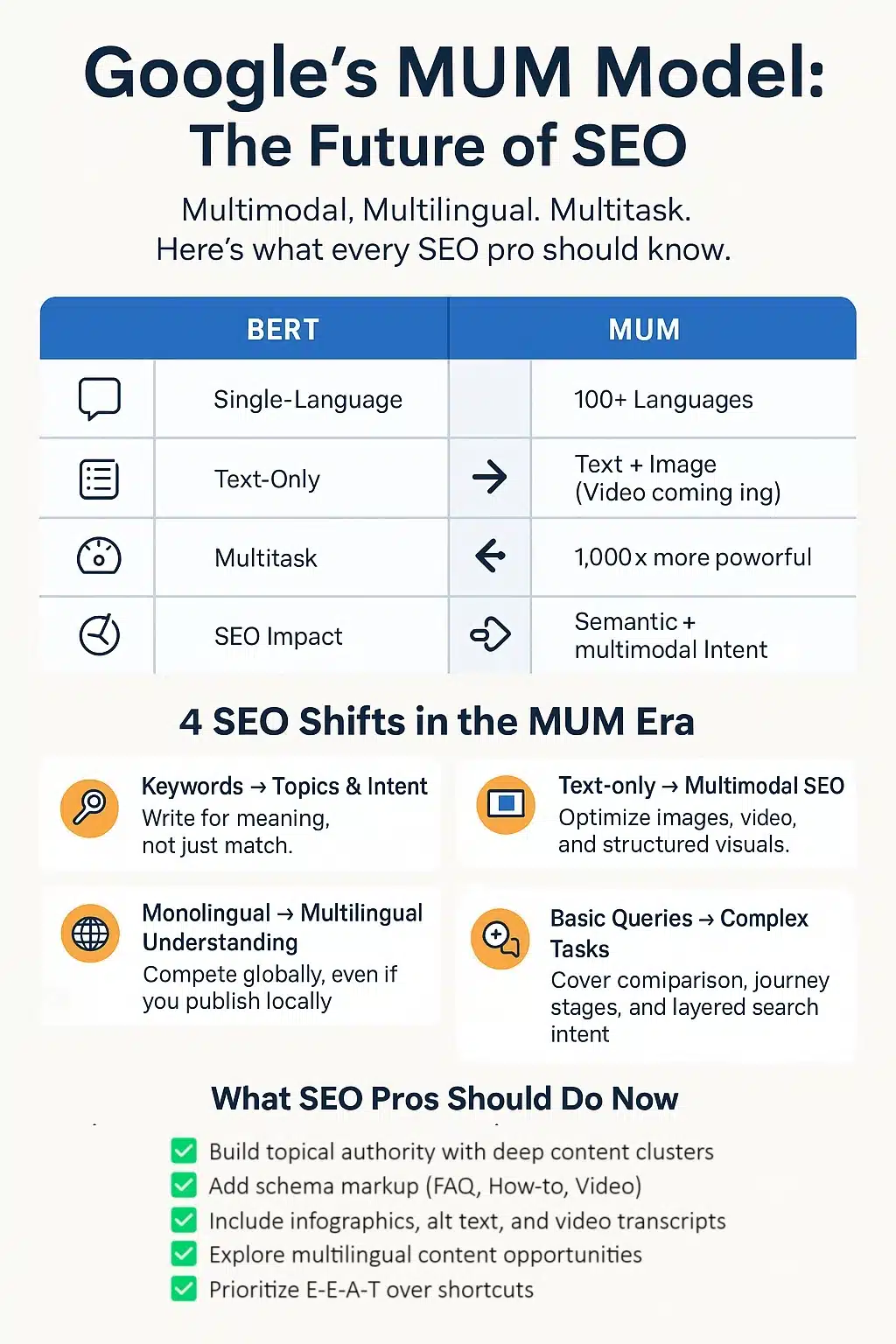Services
Free Tools
- Alpha AI
An AI writer designed to create compelling ad copy for Google, Facebook, Instagram, and email campaigns, as well as SEO-friendly blog posts and social media content. An all-in-one platform for all marketing needs.

Not long ago, SEO was all about keywords—matching search terms, optimizing metadata, and building backlinks. Then came RankBrain and BERT, ushering in smarter algorithms that understood context, not just content. Now, Google has introduced something even more powerful: MUM, the Multitask Unified Model—an AI model 1,000 times more powerful than BERT.
So, what is MUM, and why is it making waves in the SEO world?
If you’re a marketer, business owner, or SEO strategist, understanding how MUM works—and how it’s reshaping the rules of search—is no longer optional. Let’s break it down.
Table of Contents
MUM stands for Multitask Unified Model, and it’s designed to understand complex search tasks across different languages, formats, and modalities (like text, image, video, or audio).
Here’s what sets MUM apart:
Multilingual: Trained on 100+ languages to transfer knowledge globally.
Multimodal: Processes information from both text and images, with plans to include video and audio.
Multitask: Handles multiple tasks simultaneously—like understanding your query, pulling information from different sources, and generating meaningful answers.
Let’s compare:
That’s not just evolution. It’s a revolution.
Let’s dive into how MUM is changing SEO and what it means for your strategy going forward.
MUM doesn’t need a perfect keyword match. Instead, it understands what people mean, even when their searches are vague, layered, or phrased like conversations.
Search Query: “What should I do after hiking Mount Kinabalu?”
A keyword-based engine might suggest more hiking gear or nearby trails.
MUM, on the other hand, understands you’ve completed a challenging hike and may be interested in similar but different activities, like cycling routes in Southeast Asia or mountain retreats in Sabah.
🔑 Takeaway: Focus on topical depth and semantic coverage, not just keyword density.
Since MUM can understand and combine text, images, and soon even videos and audio, your SEO strategy must extend beyond written words.
That means:
Optimizing alt text for images.
Using video transcriptions.
Embedding visual explainers that enhance user understanding.
If your blog includes an infographic that helps answer a complex question, Google may use that image content—not just your text—to determine rankings.
🔑 Takeaway: Treat your multimedia content as integral to SEO, not just as decoration.
One of MUM’s biggest advantages is its ability to transfer knowledge across languages.
That means:
Google can surface the best content to answer a query, even if it’s not in the user’s native language.
A Japanese article explaining a complex medical condition could influence English SERPs—if it’s more informative.
For international SEO, this is huge.
🔑 Takeaway: Optimize content for multiple languages and use hreflang tags properly. But even if you’re focused on one region, high-quality foreign content can become your competition.
MUM doesn’t just answer “what” a user wants—it considers “why” and “how”.
That means:
Search engines will expect content that answers multiple layers of intent.
Your content should address comparison, recommendation, experience, and follow-up actions.
Think: Instead of a page that answers “What is digital marketing?”, create content that also explains “How to start,” “When to hire an agency,” and “Common mistakes.”
🔑 Takeaway: Adopt an intent-first content strategy—address multiple angles of the user journey in one helpful, organized page.
Here’s how MUM is already transforming search:
Ask, “What are the differences between hiking Mount Fuji and Mount Kinabalu?”
MUM can compare terrain, weather, gear, and skill levels—across languages and formats (even from Japanese YouTube videos or Malay blogs).
Search for treatment options across countries? MUM may pull multilingual results and combine them into context-aware answers—factoring in local practices, effectiveness, and cultural relevance.
Snap a photo of your running shoes and ask, “Can I use these for hiking?”
With MUM, Google can understand the image and your intent—then combine it with content that explains the difference between trail and road shoes.
Here’s your MUM-proof action plan:
Create content clusters (pillar + supporting pages)
Interlink naturally with clear hierarchy
Help Google understand context, entities, and content type
Use schema for FAQs, how-to guides, videos, and more
Use infographics, short videos, and descriptive images
Optimize media files with filenames, alt text, and captions
Even if you’re not targeting global traffic, understand your multilingual competitors
Explore opportunities in Malay, Chinese, or other regional languages

It’s harder to manipulate the algorithm with surface-level tactics
Search results are less predictable and increasingly personalized
Google’s focus is shifting toward Experience, Expertise, Authority, and Trust (E-E-A-T)
This means brands must truly earn their rankings through value, clarity, and helpfulness—not just keywords and backlinks.
MUM represents a shift in how Google sees the world—it’s no longer just organizing websites, but organizing knowledge.
If you’re still optimizing purely for keywords, you’re optimizing for a version of search that’s fading.
The future belongs to those who:
Understand their audience’s real questions
Offer multimodal content that informs and inspires
Build authority through value, not volume
Whether you’re managing a brand or scaling a content team, it’s time to shift from tactical SEO to strategic, MUM-ready SEO.
Let’s help you build a content and search strategy that’s built for what’s next.
Need expert guidance on MUM-aligned SEO strategies? Let’s talk.